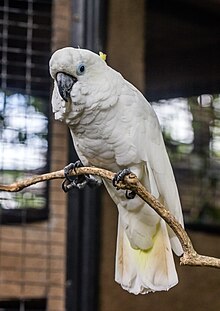Subspecies of bird
| Triton cockatoo | |
|---|---|

| |
| Scientific classification | |
| Domain: | Eukaryota |
| Kingdom: | Animalia |
| Phylum: | Chordata |
| Class: | Aves |
| Order: | Psittaciformes |
| Family: | Cacatuidae |
| Genus: | Cacatua |
| Species: | C. galerita |
| Subspecies: | C. g. triton |
| Trinomial name | |
| Cacatua galerita triton Temminick, 1849 | |
The Triton cockatoo (Cacatua galerita triton) is one of the four subspecies of the sulphur-crested cockatoo. The cockatoo was first described by Dutch zoologist, Coenraad Jacob Temminck, in 1849. There is no documentation as to why Temminck selected this name however it is suggested that it was named after the Dutch corvette, Triton, which operated off the Dutch New Guinea coastline, in 19th century.
It is considered a pest in its natural habitat.
Description
It is white, with a large yellow crest that it can raise. It is 45–55 cm (18–22 in) long, weighing 550–600 g (19–21 oz) and can live up to 40 years. This subspecies differs from the Australian greater sulphur-crested cockatoo in that it is smaller, with broader crest feathers and has a pale blue periophthalmic ring instead of white. Its head and bill appear proportionally larger to its body when compared with the greater sulphur-crested. Although the Triton cockatoo is a larger and heavier bird than the Eleonora cockatoo, in practice, it may be difficult to visually differentiate between the two subspecies.
Distribution
It can be found across most of New Guinea and the surrounding islands, including the Western Islands, the D'Entrecasteaux Islands and the Louisiade Archipelago. It can also be found throughout most of the islands in the western area of the Solomon Sea, with the exception of Aru Islands.
Habitat

The Triton Cockatoo is almost exclusively arboreal and are rarely found in groups numbering more than half a dozen individuals. They prefer the thick jungle forest found on hillsides and whilst most are commonly found in lower and moderate elevations they have been found in forests 1,850 m (6,070 ft) above sea level.
Diet
They mainly eat seeds, fruits and occasionally insects.
Breeding
They are aggressive, solitary and territorial during breeding season, which is from May to September. It nests in tree cavities, like most cockatoos. They fill the nest with leaves and vines as padding and lay 2-3 eggs, which both parents incubate for approximately 26 days.
Aviculture
Alongside the Eleonora cockatoo, avicultural populations of Triton cockatoo are well-established in Europe and the United States and young, hand-reared individuals are available for purchase.
In fiction
A Triton cockatoo, named Fred features prominently in the 1970s US TV series, Baretta as the pet of the titular character. In reality, two cockatoos named Lalah and Weird Harold were used during production.
References
- "ITIS Standard Report Page: Cacatua galerita triton". www.itis.gov. Retrieved 30 July 2020.
- "Taxonomy browser (Cacatua galerita triton)". www.ncbi.nlm.nih.gov. Retrieved 30 July 2020.
- Beolens, Bo; Watkins, Michael; Grayson, Michael (2020). The Eponym Dictionary of Birds. Bloomsbury Publishing. ISBN 9781472982698.
- "Triton Cockatoos | Beauty of Birds". www.beautyofbirds.com. Retrieved 29 July 2020.
- ^ "Triton sulphur-crested cockatoo". www.zoobarcelona.cat. Retrieved 29 July 2020.
- ^ "Sulphur-crested Cockatoo Fact Sheet". Northern Parrots. Retrieved 21 February 2022.
- ^ Beehler, Bruce M.; Pratt, Thane K. (2016). Birds of New Guinea: Distribution, Taxonomy, and Systematics. Princeton University Press. p. 240. ISBN 9781400880713.
- Harman, Ian (1981). Australian Parrots in Bush and Aviary. David & Charles. p. 190. ISBN 9780715382592.
- "Triton Cockatoo". birdfinding.info. 28 November 2019. Retrieved 3 January 2023.
- ^ Mulawka, Edward John (2016). The Cockatoos: A Complete Guide to the 21 Species. McFarland. p. 67. ISBN 9781476614717.
- "Supplement". Scientific American. 35. Munn and Company: 14548. 1893.
- "Cockatoo". San Diego Zoo. Retrieved 3 January 2023.
| Cockatoos (family: Cacatuidae) | |||||||||
|---|---|---|---|---|---|---|---|---|---|
| Appearance |
| ||||||||
| Small |
| ||||||||
| Black |
| ||||||||
| Pink or grey |
| ||||||||
| White |
| ||||||||
| Taxon identifiers | |
|---|---|
| Cacatua galerita triton | |